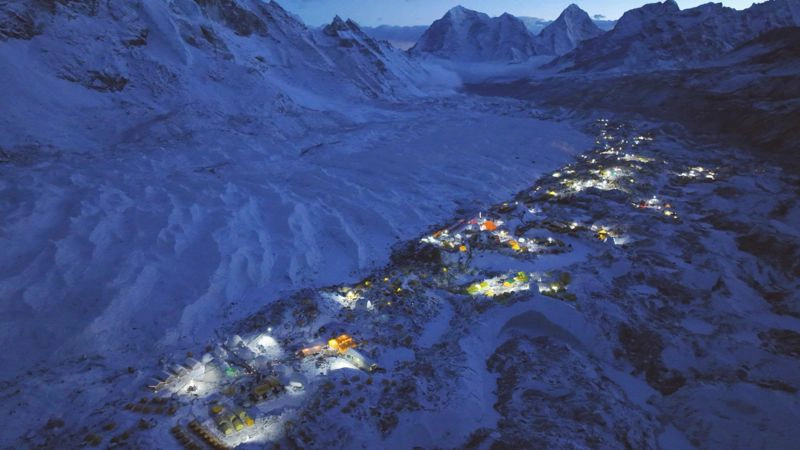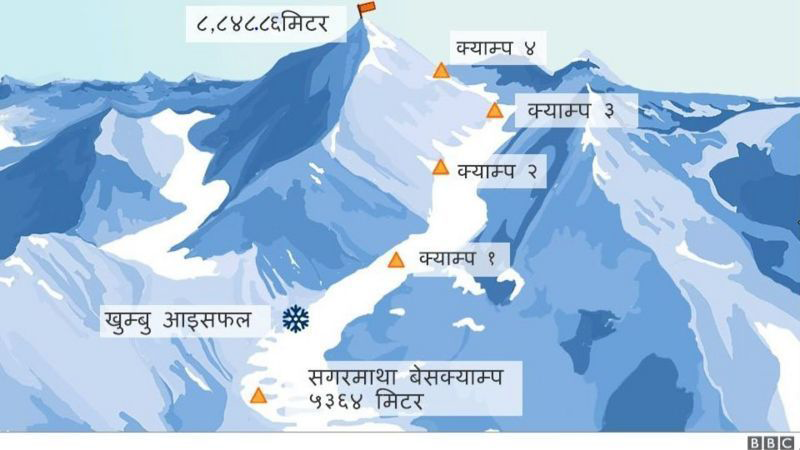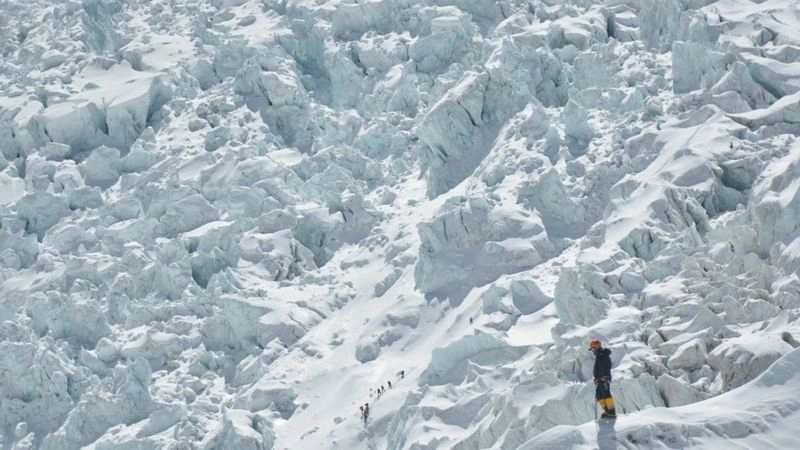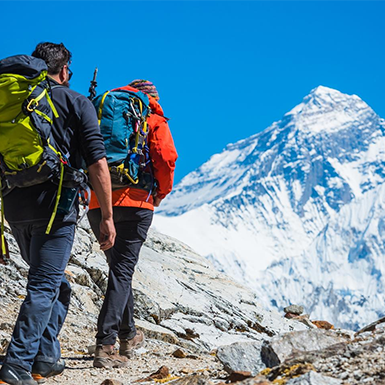According to confirmed reports, during the Mount Everest expedition this spring season, at least 12 individuals lost their lives. Officials have confirmed the loss of five individuals. The condition of the remaining persons is still unknown.
“On the 30th of Baisakh (May 13), mountaineers reached the summit of Mount Everest for the first time this year. Subsequently, until the 12th of Jestha (May 26), mountaineers successfully reached the summit of Sagarmatha on various days, as reported by officials.
During this ascent, the weather conditions were favorable, with a relatively long duration of the ‘summit window.’ However, out of the 17 incidents of fatalities and injuries, more than 8,000 meters fell within the ‘death zone.’

Khim Lal Gautam, the coordinator of the Sagarmatha Expedition Research Committee, mentioned that the snowfall was insufficient, and the snow was loose when ascending, leading to a challenging experience during the climb.
“Both the weather forecast and the actual conditions were significantly different this time,” he said.”
Despite the most permits, there was no “traffic jam.”
For this Everest climbing season, the Nepalese government issued 478 permits, the highest number.
In the Mount Everest expedition, mountaineers from 44 countries were involved, along with Nepalese Sherpas, to assist them.
Despite the high number of climbers, tourism department officials have stated that the “deadly traffic jam” situation was not observed on Mount Everest this time.
However, a Sherpa who climbed above Camp IV on May 17th and 18th reported experiencing heavy crowding, as reported by BBC News Nepali.
“Unlike before, there was not a severe traffic jam this time. However, even though it wasn’t crowded, it was still quite challenging,” said Mingma Norbu Sherpa, who has climbed Mount Everest for the tenth time.
“There was so much snow that even breathing through the oxygen mask became difficult due to ice formation. It required frequent adjustments and cleaning. Oxygen consumption was high due to the high altitude,” he added.
Where did the mountaineer’s death occur?
The deaths of mountaineers occurred at various locations on Mount Everest. According to the government’s official report, none of the confirmed deaths reached the summit. The report indicates that four deaths occurred in the sequence of descending from the highest peak.
According to the information provided by the Tourism Department, most of the deaths occurred in the area above 6,400 meters, particularly in the region from Camp II to the Hillary Step, located at approximately 8,800 meters.

In addition to the fatalities, during the preparation for the climb, a female mountaineer fell ill at the Everest Base Camp and was rescued by helicopter to Lukla. Unfortunately, she also passed away.
The mountaineer’s death occurred before reaching a favorable altitude, up to the lower part of the Khumbu Icefall.
According to Mingma Norbu Sherpa, when he reached Camp 4 on May 4, many people were seen removing and cleaning their oxygen masks. It was observed that they experienced discomfort without oxygen for two to four minutes.
“It seemed that there was a sudden change in weather with rapidly changing conditions. At a time when climbers were trying to manage the supply of oxygen, they couldn’t reach Camp 4. The weather cleared up suddenly, and then there was a sudden change in the wind,” he said.
He mentioned that there was a lot of commotion in that area, and on May 4, one person died at around 8,000 meters near the South Col, and another person died near the South Summit, close to Camp 4.
According to the information provided by the Department of Tourism, on May 5, when they returned after climbing, it was reported that one person had lost their life at the summit of South Col, and another person did not make it to the summit of Camp 4 on the same day.
Among those who were lost, two Nepalis were last seen near the South Summit, located close to the summit of Sagarmatha (Mount Everest). One of them was a Sherpa.
They were descending from the summit of Everest.
When the altitude is too high, some climbers use supplemental oxygen in higher quantities to maintain their bodies and minimize the risk associated with low oxygen levels.
When body heat dissipates more rapidly than it is generated, there is a possibility of a condition called “hypothermia,” which refers to a state of low body temperature. Such a condition can lead to weakness and confusion in individuals.
Referring to such situations commonly observed in high Himalayan regions, Yuvaraj Khadka, the Director of mountaineering at the Department of Tourism, also emphasizes the likelihood of “physical weakness in climbers” when encountering adverse weather conditions.
Before the commencement of this year’s Sagarmatha (Mount Everest) expedition, the conditions of three Sherpas who went missing due to an avalanche in the Khumbu Icefall on Chaitra 29 (a date in the Nepali calendar) are still unknown.
The Director of the Department of Tourism, Khadka, has stated that due to the area’s complex geographical and weather conditions, the possibility of them being “alive is uncertain.”
“In such circumstances, it is difficult to ascertain the chances of survival until we have concrete information,” he added.
Weather conditions
The President of the Nepal Mountaineering Association (NMA), Nimanuru Sherpa, mentioned that other issues, besides logistical challenges, were observed during this expedition.
“We faced a situation where some teams had to spend up to two nights at Camp Four due to weather conditions,” said Sherpa.
“This poses a risk of overcrowding and congestion during the summit push.”
The Department of Tourism has reported that around 600 or more individuals, including foreign mountaineers and Sherpas, have reached Camp Four during this expedition.
However, the adverse weather conditions have also resulted in a dozen rescue operations and “food shortage for more than 100 individuals,” as the Director of the Department of Tourism, Mira Acharya, reported.
“We have requested the respective companies provide reports containing the possible causes of these fatalities and incidents. Based on the review, we will take necessary actions to prevent such incidents in the coming year,” she stated.
The year of high mortality
In the past two decades, the avalanche in Khumbu Icefall in 2014 and the earthquake in 2015 that affected the Everest Base Camp are considered significant incidents. In 2014, 16 individuals lost their lives; in 2015, the number rose to 18.
However, there have been several other incidents as well. In 2019, a total of 11 people (9 Nepalis and two foreigners) lost their lives on Mount Everest.

In 1996, a massive snowstorm occurred. Along with other incidents during that season, 15 individuals died during the spring season at Mount Everest.
Before that, in 1988 and 1982, 10 and 11 individuals lost their lives on Mount Everest, according to the data collected by mountaineers and blogger Alan Arnette’s website.
Consolidated data regarding incidents on Mount Everest is not available on any official website of the Nepalese government.
Gautam, an official involved in two Everest expeditions, states, “Apart from the three Sherpas who died in the Khumbu Icefall this time, there have been intermittent incidents, and this year marks a significant milestone in the history of Mount Everest climbing.”
According to the records, in 1922, during an expedition to Mount Everest from Nepal and Tibet, there were more than 300 fatalities, with Sherpas accounting for around 40 percent of them.
Source: BBC


